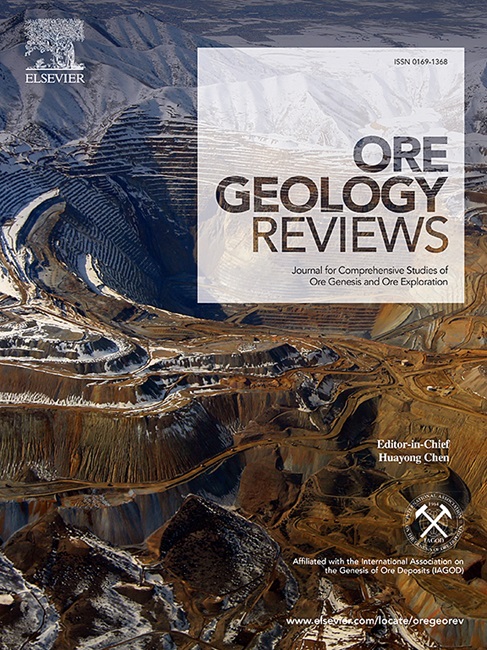尼日利亚 Nassarawa-Keffi 稀有金属伟晶岩带锡石的地质年代学:与冈瓦纳造山运动的构造联系
IF 3.2
2区 地球科学
Q1 GEOLOGY
引用次数: 0
摘要
伟晶岩通常出现在与造山运动的构造演化阶段在时间和空间上相关联的岩场、岩带或岩层中。根据稀有金属(如锂、铍和铌钽)的存在,这些岩性可分为多种类型。然而,人们对造成这些巨型伟晶岩带发展的构造环境及其对不同稀有金属矿化形成的影响仍只有部分了解。长达 400 公里的尼日利亚伟晶岩带中的 Nassarawa-Keffi 稀有金属伟晶岩含有锂、铍和铌钽矿化物,为研究各种稀有金属矿化物形成的时间、熔体来源和构造环境提供了一个独特的机会。对尼日利亚伟晶岩带 Nassarawa-Keffi 地区富含 Nb-Ta、Be 和 Li- 的伟晶岩中的锡石和锆石的岩石学、矿物学、锡石地质年代学、微量元素组成和 Lu-Hf 同位素进行了系统分析。根据锡石的 U-Pb 测定,富含 Nb-Ta 的伟晶岩的年龄为 559-548 Ma,富含 Be 的伟晶岩的年龄为 572-550 Ma,富含 Li- 的伟晶岩的年龄约为 565-550 Ma。这些年龄证实,尼日利亚伟晶岩带中的铌-钽-铍-锂矿化代表了新近纪晚期形成的约 20 Myr 的多阶段稀有金属矿化期,与冈瓦纳形成造山运动期间巴西利亚诺造山带的长期碰撞后延伸事件相对应。这些伟晶岩的锡石和锆石Hf同位素组成表明,富铌钽铍伟晶岩和富锂辉石伟晶岩的εHf(t)值介于-8.3和-20.9之间,TDM2值介于2.0和2.8 Ga之间,这表明铌钽铍伟晶岩和锂辉石伟晶岩的母熔体通常来自古近原生代基底岩石的重熔。与富锂辉石相比,富铌钽铍辉石的εHf(t)值较低,这表明它们起源于不同原岩的再加工。因此,该研究阐明了这些巨伟晶岩带内的各种矿化可能来自不同的古地壳来源。此外,尼日利亚的锂-铍-铌-钽伟晶岩与冈瓦纳西部新新生代-寒武纪过渡造山带的构造环境相似,这凸显了在长达 400 公里的伟晶岩带内进行稀有金属伟晶岩勘探的重要性。这凸显了冈瓦纳集合时期前寒武纪板块构造带的边界是全球新兴的铌-钽-铍-锂稀有金属资源来源。本文章由计算机程序翻译,如有差异,请以英文原文为准。

Geochronology of cassiterite in the Nassarawa-Keffi rare metal pegmatite belt, Nigeria: Tectonic linkages to the Gondwana-forming orogeny
Pegmatites typically appear in fields, belts, or provinces associated with a tectonomagmatic stage of orogenic evolution, both temporally and spatially. These lithologies can be categorized into multiple types by the presence of rare metals such as Li, Be, and Nb-Ta. However, the tectonic setting responsible for the development of these giant pegmatite belts, as well as their influence on the formation of different rare metal mineralization, remains only partially understood. The Nassarawa-Keffi rare metal pegmatite containing Li, Be, and Nb-Ta mineralization in the 400 km-long Nigeria pegmatite belt presents a unique opportunity to study the timing, melt source, and tectonic setting for the formation of various rare metal mineralization. The petrology, mineralogy, cassiterite geochronology, trace element composition, and Lu-Hf isotopes of cassiterite and zircon from Nb-Ta-, Be-, and Li-rich pegmatites in the Nassarawa-Keffi region of the Nigerian pegmatite belt were systematically analyzed. U-Pb dating of cassiterite yielded ages of 559–548 Ma for Nb-Ta-rich pegmatites, 572–550 Ma for Be-rich pegmatites, and approximately 565–550 Ma for Li-rich pegmatites. These ages confirm that Nb-Ta-Be-Li mineralization in the Nigerian pegmatite belt represents a ca. 20 Myr multi-stage rare metal mineralization period formed during the late Neoproterozoic, corresponding to the prolonged post-collisional extension events in the Brasiliano orogenic belt during the Gondwana-forming orogeny. The cassiterite and zircon Hf isotope compositions from these pegmatites indicate that both the Nb-Ta-Be-rich and Li-rich pegmatites exhibit εHf(t) values ranging between −8.3 and −20.9 and TDM2 values varying between 2.0 and 2.8 Ga, which suggests that the parent melts of Nb-Ta-Be and Li pegmatites were commonly derived from the remelting of the Paleoproterozoic basement rocks. The lower εHf(t) values observed in Nb-Ta-Be-rich pegmatites, in comparison to Li-rich pegmatites, indicate their origin from the reworking of distinct protoliths. Consequently, the study elucidates that diverse mineralization within these giant pegmatite belts can be derived from various ancient crustal sources. Moreover, the similarities in the tectonic setting between Li-Be-Nb-Ta pegmatites in Nigeria and the Neoproterozoic-Cambrian transition orogenic belts of western Gondwana highlight the importance or rare metal pegmatite exploration within the 400 km-long pegmatite belt. This underscores the boundary of Precambrian cratons’ tectonic zone during the Gondwana assembly as a globally emerging source for Nb-Ta-Be-Li rare metal resources.
求助全文
通过发布文献求助,成功后即可免费获取论文全文。
去求助
来源期刊

Ore Geology Reviews
地学-地质学
CiteScore
6.50
自引率
27.30%
发文量
546
审稿时长
22.9 weeks
期刊介绍:
Ore Geology Reviews aims to familiarize all earth scientists with recent advances in a number of interconnected disciplines related to the study of, and search for, ore deposits. The reviews range from brief to longer contributions, but the journal preferentially publishes manuscripts that fill the niche between the commonly shorter journal articles and the comprehensive book coverages, and thus has a special appeal to many authors and readers.
 求助内容:
求助内容: 应助结果提醒方式:
应助结果提醒方式:


